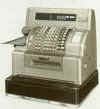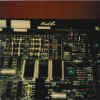The NCR 52 Cash Register
The first NCR POS terminal of sorts that I was involved with was a NCR 52 cash register that printed NCR OCR tapes at the Best Apparel store in Seattle. At the end of the day the paper OCR tapes were removed from the 52 and sent to the data center to be read on a NCR 420 OCR reader. Print quality was very important and required a lot of careful maintenance.
One of NCR's first forays in to electronic cash registers was the NCR 230.
The 230 used hard wired logic with a wire wrapped back frame on the card rack and was very complicated to repair. Training was to the component level but card swap was used on the customer site. The first installation in the Northwest was about a an hours drive from Seattle making the service even more difficult.
The NCR 280 department store POS terminal used with the 725.
One of the 280s shown has the NCR white-green-black bar code scanner pen unit attached. The first installation in the Northwest was at Nordstrom Shoes that had taken over Best Apparel to become a specialized and very successful department store. Nordstrom's had the famed NCR "Total Solution" with NCR main frames and POS systems. The communication link to the 280 was a four wire point-to-point connection from a dedicated port on the in store 751 controller. The 280 used a parameter driven programming system that was entered at the terminal keyboard. More than 10 million 280s were sold.
NCR Terminal Core Memory
The NCR 280 used non-volatile core memory to store the programming parameters. The operating system and program was in read only memory (ROM). I'm not sure if the memory board pictured is from a 280 or some of the other units like the 250 ECR.
The NCR 2151 department store POS terminal based on the Intel 8080 CPU.
The first controlled release installation of the 2151 system was at the Rike's Department store in Dayton Mall. The second installation was at the Bon Marche' Department store located in the Everett Mall north of Seattle. The 2151 was one of the first NCR terminals designed around off the shelf components, e.g. Intel CPU, memory chips and logic. The communication link to the 2150 was a four wire point-to-point connection from a dedicated port on the in store 751 controller. The 2150 had a pretty advanced programming system and the program could be down loaded from the 725 or T8270. The 2151 used DRAM memory that required refresh. To keep the refresh running with the power off it was equipped with a large 12v jell cell battery. A small amount of CMOS memory supported with a nicad battery was used to store critical data like the transaction numbers, date, etc.
The NCR 2151 Input Output Board
Partial view of the NCR 2151 I/O board showing the printer driver logic. The 2151 did not use the typical card bay. Instead the cards were stacked on top of each other and connected using Zero Insertion Force (ZIF) connecters. Power, cables to the printer, display and keyboard connected on the back edge of the board.
The NCR 2152
The 2152 department store POS terminal based on the Intel 8086 CPU. Never had a chance to work with these.
The 255 POS grocery store terminal and UPC scanner
The first NCR 255 installation in the Northwest was at the Greenwood Avenue Albertson's store in Seattle. The early NCR UPC scanners were made by Spectra Physics and were enormous units that required two people to lift them out of the check stand. The 255 system used a high speed 1.5 MB daisy chained communication link that attached to each terminal. Each terminal had a fixed address on the network and was polled by the 726. There were clips on the communication broad inside the 255 to set the address for each terminal. The system installation in existing stores usually required installing new floor walker duct for the communications cables and new power to the check stand. The 726 was usually located in the manager's cramped office near the front of the store with junk piled on it. .
.
.










